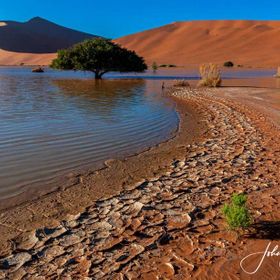This is a place along the Namibian coast where the sand-dunes collide with the Atlantic ocean and it's called, Sylvia Hill....
Read more
This is a place along the Namibian coast where the sand-dunes collide with the Atlantic ocean and it's called, Sylvia Hill.
Read less
Read less
Views
219
Likes
Awards
Action Award
Zenith Award
Creative Winter Award
Curator's Selection
Member Selection Award
Top Choice
Superb Composition
Absolute Masterpiece
Outstanding Creativity
Peer Award
All Star
Categories
Same photographer See allBehind The Lens
Discover more photos See all
Behind The Lens
Location
This is a place called Sylvia Hill along the Namibian coast, roughly in the middle between Walvis Bay and Luderitz.Time
This was taken late in the afternoon and luckily we had sunshine as many days are covered in mist or fog from the ocean, which wouldn't presented the same effect.Lighting
As it was late in the day, the low sunlight from the west created lovely contours and textures in the foreground where the sand-ripples are. The side-light also ensured good contrast without being too harsh so that there was a nice balance between sunlight and shadow.Equipment
This was still taken with my old trusted Nikon D90 crop-camera and the 18-105 mm zoom lens. Because there was more than enough light for a small aperture of f-11, I still got 1/100 sec. exposure for a clean crisp shot without having to resort to a tripod.Inspiration
I was on a photographic tour with clients and luckily I was in the first car so I could get to the best spots first, which is very important for me a photographer as I and most serious photographers would want a clean shot devoid of tracks that can ruin an otherwise great landscape photo.Editing
Yes as I only shoot in RAW format, I have to do post-processing. I use Adobe Lightroom mainly and only use Photoshop for certain needs like when I want to work with different layers as an example. Lightroom makes it quite easy to develop or adjust images fast. I usually trust the "Auto" function in the Develop module and then I just do small adjustments from there.In my camera bag
Nowadays I have two camera bodies, namely my Nikon D90 and also a Nikon D7100. For general photography I use mainly two lenses that are both connected to the cameras, namely a Nikon 16-35 mm wide-angle zoom lens and a 70-200 mm, f2.8 zoom lens. I also have a new Sigma 150-600 mm zoom lens that I mainly use for wildlife and sports. I also have two Yongnuo flashes, one for each camera and a Benro tripod.Feedback
My advice for landscape photographers is to where possible, make use of a tripod to help with composition and ensure a sharp photo especially at low light levels. A wide-angle lens is almost necessary for landscapes because of the often wide spaces to be captured. To ensure good focus and sharpness from front to back, focus about one-third into the picture and make use of a small aperture like f-11 or f-16. Shoot as much as possible even if the weather is bad because sometimes something surprising happens that provide good photo opportunities.













































